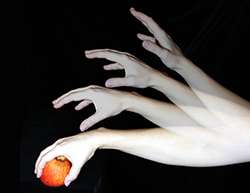A brain area responsible for grasping

(Medical Xpress)—The research group led by Silvia Arber at the Friedrich Miescher Institute for Biomedical Research and the Biozentrum of the University of Basel has shown that limb motor control is regulated by a selective synaptic connectivity matrix between the brainstem and the spinal cord. In particular, the researchers have pinpointed a brainstem area responsible for the control of grasping. This is the first time it has been possible to link defined neuronal circuit elements unequivocally to a specific phase of movement. The findings were published in Nature.
For most people who try to grasp a small ball with their toes, the difference between the motor skills of the hands and feet is immediately obvious. But for scientists looking at the neurons that control limb movements, the reason for why this is the case has not been so apparent. In the case of both hand and foot, circuits in the brain connect to spinal motor neurons, which in turn control the various limb muscles. It has not been clear however where specialization occurs, which neuronal circuits account for the differences between hand and foot motor control and how they do so. Silvia Arber and her team at the Friedrich Miescher Institute for Biomedical Research and the Basel University Biozentrum have now investigated the circuits in the brain underlying these differences.
Connectivity matrix between brainstem and spinal cord
In a study published in Nature today, the Basel-based neurobiologists show that the mouse brainstem comprises a number of areas controlling movement via highly specialized connections to the spinal cord.
The work involved the use of state-of-the art methods for visualizing connections between neurons. The researchers were thus able to reveal the three-dimensional connectivity matrix between the brainstem and spinal cord motor neurons. They found that brainstem neurons connected to motor neurons innervating the mouse forelimb (corresponding to the human arm) reside in part in different areas than those targeting hindlimb-innervating motor neurons. Forelimb control was particularly pronounced in an area known as the brainstem nucleus medullary reticular formation ventral part – or MdV for short.
But there are not only differences between the hind- and forelimbs in general. The researchers also found that neurons residing in particular brainstem areas show connection biases towards motor neurons with different functions. Thus, neurons in certain areas have preferential connections to biceps and others to triceps motor neurons, while others again are connected to both. "This means that there is a specific connectivity matrix for brainstem input to numerous functionally distinct motor neurons," says Silvia Arber.
A brainstem area for grasping
To assess the importance of this connectivity matrix for movements, the researchers analyzed neurons in one of the brainstem areas – the MdV – in more detail. Having first determined that MdV neurons control fine, but not gross, motor tasks, they studied each individual phase of a skilled motor task – retrieval of a single food pellet – in isolation. They found that MdV neurons control only the phase of grasping a pellet, and not the phases of initial reaching or subsequent transfer of the food to the mouth.
Arber comments: "If we want to understand how movements arise and are controlled, then we first have to understand the structure of the various neural circuits involved. In our study, we've identified a first level of connections controlling a clearly defined movement. We assume that an elaborate matrix responsible for a wide range of movements will ultimately be revealed at the level of the brainstem."
More information: Esposito MS, Capelli P, Arber S (2014) "Brainstem nucleus MdV mediates skilled forelimb motor tasks." Nature, 2014.
















